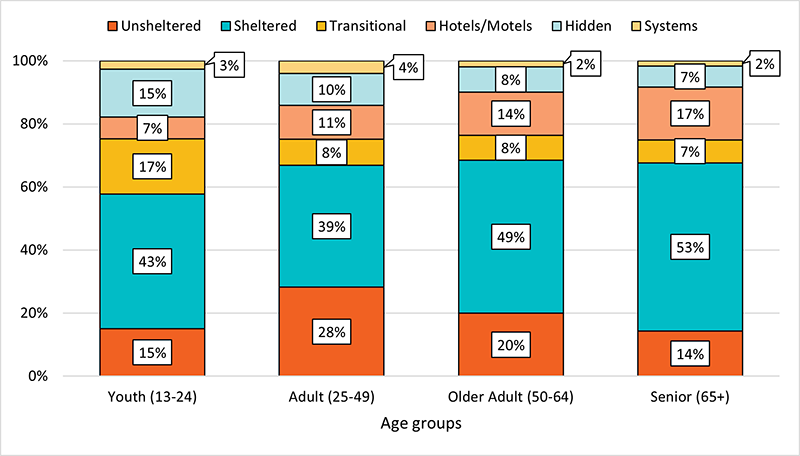Everyone Counts 2020-2022: Preliminary Highlights Report
Everyone Counts 2020-2022: Preliminary Highlights Report
On this page
Introduction
Point-in-Time (PiT) Counts provide a one-day snapshot of homelessness in a community, including people experiencing homelessness in shelters, unsheltered locations, and transitional housing. They can also include people experiencing homelessness who are in health or correctional facilities or who are staying with others because they have no access to a permanent residence.
The first and second nationally Coordinated Point-in-Time Counts were held in 2016 and 2018. The findings from the these counts can be found at the following linked reports:
- Highlights – 2016 Coordinated Point-in-Time Count of Homelessness in Canadian Communities
- Everyone Counts 2018: Highlights
Between March 2020 and December 2022, 66 communities participated in Everyone Counts, the third nationally coordinated Point-in-Time (PiT) Count of homelessness in Canadian communities. This report presents preliminary findings from the enumeration and surveys conducted in nearly 90% of the participating communities. The results are expected to be updated as more data are made available.
Acknowledgements
This report was prepared by Sajidul Quayum, Caren Love and Linda Chen from Infrastructure Canada and reflects the work by the PiT Count Implementation team at Infrastructure Canada, the National PiT Count Working Group and all of the 66 communities that participated in Everyone Counts. Each count was led by a local team, relying on dedicated people working with homelessness serving organizations, municipal staff, emergency services and volunteers who took the time to have conversations with people experiencing homelessness, to listen to their stories and understand their needs.
Methodology
The Point-in-Time Counts, held between March 2020 and December 2022, provide a unique community-wide view of homelessness that reaches beyond those who are accessing other homelessness services. PiT Counts result in an enumeration of homelessness in "core" locations, including:
- Unsheltered locations such as streets, alleys, parks, transit stations, abandoned buildings, vehicles, ravines, and other outdoor locations where people experiencing homelessness are known to sleep.
- Sheltered locations such as emergency shelters, extreme weather shelters, Domestic Violence shelters, and where applicable, it may also include hotel or motel rooms provided to families or individuals experiencing homelessness in lieu of shelter beds.
- Transitional housing such as programs that provide longer-term housing solutions with supports intended to help individuals transition from homelessness to secure housing.
The PiT Counts also include a survey of people experiencing homelessness across the community, which also includes people experiencing homelessness in health and corrections systems, as well as people who are temporarily staying with others without access to safe housing of their own (e.g., "couch surfing"). The methodology for Everyone Counts provides core standards followed by the 66 communities, including a common set of screening and survey questions. The survey questions and additional information on the counts can be found in the Guide to PiT Counts and on the Core standards page.
Enumeration
During the night of the PiT Count Enumeration, over 32,000 people in 59 communities across Canada were identified as experiencing absolute homelessness in shelters, transitional housing and unsheltered locations.
Figure 1: Overnight location

-
Figure 1 - Text version
Locations Percentage Unsheltered 25% Sheltered 63% Transitional Housing 12%
Across the 55 communities that also conducted a count in 2018, there was a 12% increase in the enumeration. This increase can be attributed to the impacts of the COVID-19 pandemic as well as improvements in the methodology. Compared to 2018, those enumerated in an unsheltered location doubled (a 100% increase), while those in sheltered locations increased by 3%, and the number of people in transitional housing decreased by 22%.
Survey results
Across 59 communities during the 2020-2022 period, over 20,000 people were surveyed experiencing homelessness in unsheltered locations, shelters, transitional housing, staying with others, hotels or motels, health or corrections systems, and in unknown locations. The results of each analysis includes all of those who provided a response to each question.
Duration of homelessness
Survey respondents were asked how long they experienced homelessness over the past year. People with six or more months of homelessness are considered to be experiencing chronic homelessnessFootnote 1. People experiencing chronic homelessness accounted for 71% of all respondents, which is higher than what was reported in 2018 (60%). The proportion identified as chronic was typically higher among those who were in unsheltered locations (84%), followed by those in Hotels/Motels (73%) and those experiencing hidden homelessness (68%).
Overnight location
Respondents were asked about their overnight location on the night of the PiT Count. Those who identified as male represented the majority in most overnight locations, with the exception of transitional housing.
Figure 2: Gender and overnight location

-
Figure 2 - Text version
Unsheltered Sheltered Transitional Hotels/Motels Hidden Systems Man 69% 64% 49% 60% 57% 76% Woman 29% 33% 49% 39% 41% 22% Gender Diverse 3% 3% 2% 1% 2% 2%
Reported overnight location varied with age. While all respondents were most likely to indicate that they were spending the night in shelter, youth were more than twice as likely to indicate they were staying in transitional housing, while adults were most likely to indicate they were staying in unsheltered areas. Experiences of hidden homelessness tended to decrease with age, whereas older adults and seniors were more likely to indicate that they were staying in a hotel or motel shelter program.
Figure 3: Age and overnight location

-
Figure 3 - Text version
Unsheltered Sheltered Transitional Hotels/Motels Hidden Systems Youth (13-24) 15% 43% 17% 7% 15% 3% Adult (25-49) 28% 39% 8% 11% 10% 4% Older Adult (50-64) 20% 49% 8% 14% 8% 2% Senior (65+) 14% 53% 7% 17% 7% 2%
Homelessness experience
Respondents were asked about the age at which they first experienced homelessness. Approximately 46% of all respondents experienced homelessness for the first time when they were less than 25 years of age.
Figure 4: Age of first homelessness experience

-
Figure 4 - Text version
Age Percentage Child (0-12) 6% Teen (13-17) 22% Young Adult (18-24) 18% Adult (25-49) 40% Older Adult (50-64) 12% Senior (65+) 2%
Indigenous Identity
Over one third of respondents (35%) identified as Indigenous, with the majority identifying as First Nations. In contrast, approximately 5% of the Canadian population identified as Indigenous in the 2021 census, suggesting an overrepresentation of Indigenous Peoples experiencing homelessness. This percentage was higher among those who were staying in unsheltered locations, those staying in systems, and those who were staying with others. This suggests that shelter-specific statistics are likely to underestimate the extent of Indigenous homelessness.
Other key findings
- The majority (62%) of survey respondents identified as male, 36% as female, and 2% as gender diverse.
- Adults accounted for over half (55%) of respondents, 23% were older adults, 18% were children and youth and 4% were seniors.
- The majority of 2SLGBTQI+ responses were among youth respondents, where almost 1 in 4 (24%) youth identified as 2SLGBTQI+. The proportion was smaller among older age groups, accounting for 12% of adults, 6% of older adults, and 5% of seniors.
- Respondents who identified as veterans of the Canadian Armed Forces and RCMP accounted for 1 in 20 of all respondents (5%), and tended to be older than non-veterans.
Conclusions
Data from the third nationally-coordinated Point-in-Time Counts are still being collected and reviewed from communities. Further results from Everyone Counts 2020-22 is expected to be reported in future analyses, including experiences of youth-in-care, reasons people cite for housing loss, health challenges, income sources, homelessness among immigrants and refugees, and deeper analyses on specific populations.
The findings in this report may be subject to change as the data are updated. If you have questions about this report, contact hpd.data-donnees.dpmi@infc.gc.ca.
Report a problem on this page
- Date modified:
